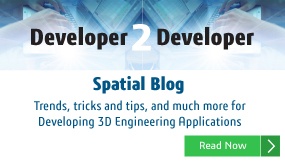

From being a best practice in the AEC space to a growing number of governments mandating it, Building Information Modeling (BIM) adoption is growing. In fact, the BIM market is projected to grow to USD $10.36 billion in value by 2022.
This is certainly a major opportunity for independent software vendors (ISV) looking to enter the AEC space with custom applications. However, simply rolling out a BIM application isn’t going to guarantee you AEC end-users. To capture market share, you must solve the problems AEC users are having with existing off-the-shelf BIM applications.
There are multiple aspects to this.
First, the user interface in of your BIM application should be intuitive and reliable. This area is entirely under your control, though it requires you to understand how AEC professionals could use your software and common end-user concerns, such as lag or application crashes.
Second, ensuring that your BIM user interface matches the need.
Not every BIM application is the same, nor will it be used the same way.
For example, the building or project owner will likely want to see how their project looks from an overall aesthetic standpoint, they will not care about the positioning of studs, the insides of each column, the plumbing, or the HVAC system.
Moreover, packing all of those details could make for a difficult user-interface for those users. It may even adversely affect the performance of your application by requiring too many graphics, memory, and processing resources from the device (e.g., a smartphone).
Conversely, a ‘lite’ BIM viewing application will not help mechanical, electrical, and plumbing (MEP), civil, or HVAC engineers who need to see the design in intricate detail. In such cases, you can expect AEC professionals to have more powerful hardware (e.g., dedicated graphics cards) and, in turn, drive more information to them.
But putting in the software capabilities is not enough, the BIM user interface must enable the end-user to draw on all of that capability in a seamless way.
Provide the 3D Visualization Capabilities Your
Users Want Without Coding from Scratch
In effect, you cannot solve every BIM requirement on the market with just one application.
To address the needs of engineers, architects, and building or project owners, you must provide different applications for each AEC segment. Furthermore, you must ensure that your BIM user experience works within the workflow of each of AEC segment.
BIM visualization is a complex undertaking, especially when MEP elements such as HVAC are involved. It requires massive files and copious amounts of data, which certain AEC users want to see and interact with, especially for fluid dynamics analysis and clash detection.
However, without properly integrating -- and updating -- the underlying data libraries and 3D modelers, you will not provide the BIM visualization capabilities your users expect.
Unlike BIM user interfaces, ISVs might not have as much flexibility in this area.
In theory, you can invest in building the necessary 3D modeling kernels and data libraries and ensuring that you are leveraging industry standard APIs, such as DirectX and OpenGL. But is this an efficient use of your limited development resources?
As noted above, getting the BIM user interface and BIM user experience right is essential, but this requires dedicated development resources. However, if you split that with supporting your underlying 3D visualization requirements, you could end up failing on all fronts.
If the 3D modeler’s original vendor updates their data library, your application will be behind. In addition, you will need to update your libraries while also dealing with your routine updates, bug fixes, and other maintenance work. Something will get compromised, and if it is the data library, then your application will cease working, which will drive away your AEC users.
What’s the Solution?
You should get a software partner to handle the 3D modelers, data library, DirectX/OpenGL API integration, and other BIM output capabilities. This vendor will update those components, hence ensuring that your software is up-to-par with competitors, if not ahead.
It will also free you to focus on perfecting your BIM user interface. You could also use the same tools to develop a library of BIM software and, in turn, provide specific BIM user experiences for each AEC workflow. In fact, by relying on SDKs for 3D visualization and other BIM capabilities, you will find that developing multiple BIM applications is feasible.
More on Developing BIM Applications:
With Spatial’s BIM InterOp, 3D InterOp, HOOPS Visualize, and 3D Modeling (3D ACIS Modeler and CGM Core Modeler) SDKs, you will be equipped to develop a range of full-featured BIM applications without having to develop or maintain the most complex parts of such software.
ACIS, 3DScript and SAT are registered trademarks of Spatial Corp.
No Comments Yet
Let us know what you think